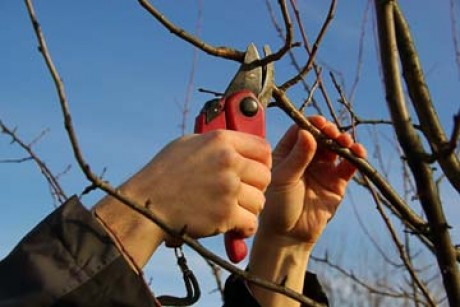Prune Properly
By Katie Lamar Jackson

Pruning plants can be an exercise in self doubt. Will I cut too much or too little? Will I snip the right limbs at the right locations? Will I get so clip-happy that my shrubs are bald?
Relax. Pruning doesn't have to be an onerous task.
The first rule of prudent pruning is to have a plan and a goal before you make the first cut. Decide in advance if you are pruning to reshape a plant, remove dead or diseased limbs, rejuvenate a neglected plant or induce more blooms or fruit.
The second rule is to remember that pruning is good for most woody plants. It stimulates growth, removes dead or dying limbs and allows for better air movement and light penetration into a plant's interior.
The third rule is to remember that more is less, and less is more. Frequent, light pruning is usually more effective for trees, plants and shrubs (and even some annual flowers that benefit from deadheading or pinching back to promote better growth and blooming) than occasional extreme pruning.
Pruning procedures
There are two basic types of pruning procedures—thinning and heading. Thinning allows you to remove select limbs and shoots from inside and outside the plant canopy so that plants look more kempt, but still retain their natural form. You take out entire limbs and stems, cutting them right where they join other limbs or the trunk, but doing so selectively so the general shape of the plant is not altered.
Heading, on the other hand, usually involves cutting the tops (and sometimes sides) off of plants to greatly reduce their size and volume. This promotes more vigorous regrowth than thinning, but also causes the plant to form a dense, compact growth habit that changes its natural shape. Heading is often the best way to rejuvenate plants that have gotten too big and gangly or simply need a fresh start. It is also the basic premise used to hedge shrubs along walkways and in formal garden settings.
Regardless of whether you thin or head your plants, follow the "rule of thirds"—reduce the size of the plant or the number of stems on a plant by no more than one-third each time you prune.
Timing & tools
The next big issue is the timing of your pruning activity. You can prune dead or diseased limbs at any time during the year, but more extensive pruning should be done at fairly specific times of year depending on the plant. Timing varies depending on local climates, so it's always safer to check with local plant experts for a local timetable. Generally, though, flowering or fruiting shrubs can be pruned after they finish blooming or fruiting, while many fruit trees are best pruned when they are dormant.
Finally, always use sharp pruning tools so the cut will be clean and try to cut into live wood or stem but avoid injuring the bark around the remaining branches. And do not use pruning paints or dressings. Research has shown these do not promote healing and may even trap bugs or diseases in the stem.
Once you get the hang of it, pruning can be an almost artistic exercise. Who knows, you may be the next Edward Scissorhands.
About the Author
Katie Jackson is a writer, editor and photographer for the Alabama Agricultural Experiment Station and Auburn University College of Agriculture, with more than 25 years of experience reporting on science, agriculture and the environment.-
Share this story:


